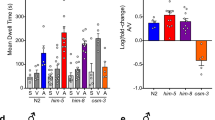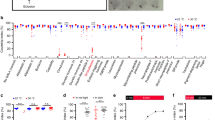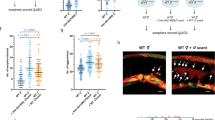Abstract
Appetitive behaviors require complex decision making that involves the integration of environmental stimuli and physiological needs. C. elegans mate searching is a male-specific exploratory behavior regulated by two competing needs: food and reproductive appetite. We found that the pigment dispersing factor receptor (PDFR-1) modulates the circuit that encodes the male reproductive drive that promotes male exploration following mate deprivation. PDFR-1 and its ligand, PDF-1, stimulated mate searching in the male, but not in the hermaphrodite. pdf-1 was required in the gender-shared interneuron AIM, and the receptor acted in internal and external environment-sensing neurons of the shared nervous system (URY, PQR and PHA) to produce mate-searching behavior. Thus, the pdf-1 and pdfr-1 pathway functions in non–sex-specific neurons to produce a male-specific, goal-oriented exploratory behavior. Our results indicate that secretin neuropeptidergic signaling is involved in regulating motivational internal states.
This is a preview of subscription content, access via your institution
Access options
Subscribe to this journal
Receive 12 print issues and online access
$209.00 per year
only $17.42 per issue
Buy this article
- Purchase on Springer Link
- Instant access to full article PDF
Prices may be subject to local taxes which are calculated during checkout





Similar content being viewed by others
References
Pfaff, D.W. The Physiological Mechanisms of Motivation (Springer Verlag, 1982).
Frisch von, O. Animal Migration (Harper Collins, 1969).
Reppert, S.M. A colorful model of the circadian clock. Cell 124, 233–236 (2006).
Mowrey, W.R. & Portman, D.S. Sex differences in behavioral decision-making and the modulation of shared neural circuits. Biol. Sex Differ. 3, 8 (2012).
Bendesky, A. & Bargmann, C.I. Genetic contributions to behavioural diversity at the gene-environment interface. Nat. Rev. Genet. 12, 809–820 (2011).
Lipton, J., Kleemann, G., Ghosh, R., Lints, R. & Emmons, S.W. Mate searching in Caenorhabditis elegans: a genetic model for sex drive in a simple invertebrate. J. Neurosci. 24, 7427–7434 (2004).
Barrios, A., Nurrish, S. & Emmons, S.W. Sensory regulation of C. elegans male mate-searching behavior. Curr. Biol. 18, 1865–1871 (2008).
Kleemann, G., Jia, L. & Emmons, S.W. Regulation of Caenorhabditis elegans male mate searching behavior by the nuclear receptor DAF-12. Genetics 180, 2111–2122 (2008).
Janssen, T. et al. Functional characterization of three G protein–coupled receptors for pigment dispersing factors in Caenorhabditis elegans. J. Biol. Chem. 283, 15241–15249 (2008).
Janssen, T. et al. Discovery and characterization of a conserved pigment dispersing factor–like neuropeptide pathway in Caenorhabditis elegans. J. Neurochem. 111, 228–241 (2009).
Wicks, S.R., Yeh, R.T., Gish, W.R., Waterston, R.H. & Plasterk, R.H. Rapid gene mapping in Caenorhabditis elegans using a high density polymorphism map. Nat. Genet. 28, 160–164 (2001).
Janke, D.L. et al. Interpreting a sequenced genome: toward a cosmid transgenic library of Caenorhabditis elegans. Genome Res. 7, 974–985 (1997).
Stewart, H.I. et al. Lethal mutations defining 112 complementation groups in a 4.5 Mb sequenced region of Caenorhabditis elegans chromosome III. Mol. Gen. Genet. 260, 280–288 (1998).
Bendesky, A., Tsunozaki, M., Rockman, M.V., Kruglyak, L. & Bargmann, C.I. Catecholamine receptor polymorphisms affect decision-making in C. elegans. Nature 472, 313–318 (2011).
Milward, K., Busch, K.E., Murphy, R.J., de Bono, M. & Olofsson, B. Neuronal and molecular substrates for optimal foraging in Caenorhabditis elegans. Proc. Natl. Acad. Sci. USA (2011).
Gloria-Soria, A. & Azevedo, R.B.R. npr-1 regulates foraging and dispersal strategies in Caenorhabditis elegans. Curr. Biol. 18, 1694–1699 (2008).
Dickson, L. & Finlayson, K. VPAC and PAC receptors: from ligands to function. Pharmacol. Ther. 121, 294–316 (2009).
Kimura, K.D., Tissenbaum, H.A., Liu, Y. & Ruvkun, G. daf-2, an insulin receptor-like gene that regulates longevity and diapause in Caenorhabditis elegans. Science 277, 942–946 (1997).
Ogg, S. et al. The Fork head transcription factor DAF-16 transduces insulin-like metabolic and longevity signals in C. elegans. Nature 389, 994–999 (1997).
You, Y.-J., Kim, J., Raizen, D.M. & Avery, L. Insulin, cGMP and TGF-β signals regulate food intake and quiescence in C. elegans: a model for satiety. Cell Metab. 7, 249–257 (2008).
Hills, T., Brockie, P.J. & Maricq, A.V. Dopamine and glutamate control area-restricted search behavior in Caenorhabditis elegans. J. Neurosci. 24, 1217–1225 (2004).
Wakabayashi, T., Kitagawa, I. & Shingai, R. Neurons regulating the duration of forward locomotion in Caenorhabditis elegans. Neurosci. Res. 50, 103–111 (2004).
Gray, J.M., Hill, J.J. & Bargmann, C.I. A circuit for navigation in Caenorhabditis elegans. Proc. Natl. Acad. Sci. USA 102, 3184–3191 (2005).
Chalasani, S.H. et al. Dissecting a circuit for olfactory behavior in Caenorhabditis elegans. Nature 450, 63–70 (2007).
Barr, M.M. & Sternberg, P.W. A polycystic kidney-disease gene homologue required for male mating behavior in C. elegans. Nature 401, 386–389 (1999).
Barr, M.M. et al. The Caenorhabditis elegans autosomal dominant polycystic kidney disease gene homologs lov-1 and pkd-2 act in the same pathway. Curr. Biol. 11, 1341–1346 (2001).
Flowers, E.B. et al. The Groucho ortholog UNC-37 interacts with the short Groucho-like protein LSY-22 to control developmental decisions in C. elegans. Development 137, 1799–1805 (2010).
Kage, E. et al. MBR-1, a novel helix-turn-helix transcription factor, is required for pruning excessive neurites in Caenorhabditis elegans. Curr. Biol. 15, 1554–1559 (2005).
Aurelio, O. Immunoglobulin-domain proteins required for maintenance of ventral nerve cord organization. Science 295, 686–690 (2002).
Bargmann, C. I. Beyond the connectome: how neuromodulators shape neural circuits. Bioessays 34, 458–465 (2012).
Bermant, G. & Davidson, J. Biological Bases of Sexual Behavior (Harper & Row, 1974).
Portman, D.S. Genetic control of sex differences in C. elegans neurobiology and behavior. Adv. Genet. 59, 1–37 (2007).
Jarrell, T.A. et al. The connectome of a decision-making neural network. Science 337, 437–444 (2012).
Fujii, S. & Amrein, H. Ventral lateral and DN1 clock neurons mediate distinct properties of male sex drive rhythm in Drosophila. Proc. Natl. Acad. Sci. USA 107, 10590–10595 (2010).
Cardoso, J.C., Pinto, V.C., Vieira, F.A., Clark, M.S. & Power, D.M. Evolution of secretin family GPCR members in the metazoa. BMC Evol. Biol. 6, 108 (2006).
Soria, V. et al. Differential association of circadian genes with mood disorders: CRY1 and NPAS2 are associated with unipolar major depression and CLOCK and VIP with bipolar disorder. Neuropsychopharmacology 35, 1279–1289 (2010).
Ressler, K.J. et al. Post-traumatic stress disorder is associated with PACAP and the PAC1 receptor. Nature 470, 492–497 (2011).
Tursun, B., Patel, T., Kratsios, P. & Hobert, O. Direct conversion of C. elegans germ cells into specific neuron types. Science 331, 304–308 (2011).
Coates, J.C. & de Bono, M. Antagonistic pathways in neurons exposed to body fluid regulate social feeding in Caenorhabditis elegans. Nature 419, 925–929 (2002).
Morsci, N.S. & Barr, M.M. Kinesin-3 KLP-6 regulates intraflagellar transport in male-specific cilia of Caenorhabditis elegans. Curr. Biol. 21, 1239–1244 (2011).
Yu, S., Avery, L., Baude, E. & Garbers, D.L. Guanylyl cyclase expression in specific sensory neurons: a new family of chemosensory receptors. Proc. Natl. Acad. Sci. USA 94, 3384–3387 (1997).
Maricq, A.V., Peckol, E., Driscoll, M. & Bargmann, C.I. Mechanosensory signaling in C. elegans mediated by the GLR-1 glutamate receptor. Nature 378, 78–81 (1995).
Lee, R.Y., Sawin, E.R., Chalfie, M., Horvitz, H.R. & Avery, L. EAT-4, a homolog of a mammalian sodium-dependent inorganic phosphate cotransporter, is necessary for glutamatergic neurotransmission in Caenorhabditis elegans. J. Neurosci. 19, 159–167 (1999).
Pujol, N. et al. A reverse genetic analysis of components of the Toll signaling pathway in Caenorhabditis elegans. Curr. Biol. 11, 809–821 (2001).
Zhang, Y. et al. Identification of genes expressed in C. elegans touch receptor neurons. Nature 418, 331–335 (2002).
Altun, Z.F., Chen, B., Wang, Z.W. & Hall, D.H. High-resolution map of Caenorhabditis elegans gap junction proteins. Dev. Dyn. 238, 1936–1950 (2009).
Lickteig, K.M. et al. Regulation of neurotransmitter vesicles by the homeodomain protein UNC-4 and its transcriptional corepressor UNC-37/groucho in Caenorhabditis elegans cholinergic motor neurons. J. Neurosci. 21, 2001–2014 (2001).
Boulin, T., Etchberger, J.F. & Hobert, O. Reporter gene fusions. in WormBook (ed. The C. elegans Research Community) doi:10.1895/wormbook.1.106.1 (2006).
Bargmann, C.I. & Avery, L. Laser killing of cells in Caenorhabditis elegans. Methods Cell Biol. 48, 225–250 (1995).
Acknowledgements
We thank the Maricq (University of Utah), Rongo (Rutgers University) and Hobert (Columbia University) laboratories for strains and reagents, and the Mitani laboratory (Tokyo Women's Medical College) and Japan's National BioResource Project for mutants. Additional strains were obtained from the Caenorhabditis Genetics Center. We thank R. Poole and members of the Barr laboratory for advice and many helpful discussions on the manuscript and L. Vaynerchuk for experimental aid. This research was supported by US National Institutes of Health grant 2R01DK059418 to M.M.B.
Author information
Authors and Affiliations
Contributions
A.B. designed and performed the experiments and co-wrote the manuscript. R.G. performed the genetic screen. C.F. contributed to mapping process. S.W.E. and M.M.B. co-wrote and discussed the manuscript with A.B.
Corresponding author
Ethics declarations
Competing interests
The authors declare no competing financial interests.
Supplementary information
Supplementary Text and Figures
Supplementary Figures 1–3 (PDF 1428 kb)
Rights and permissions
About this article
Cite this article
Barrios, A., Ghosh, R., Fang, C. et al. PDF-1 neuropeptide signaling modulates a neural circuit for mate-searching behavior in C. elegans. Nat Neurosci 15, 1675–1682 (2012). https://doi.org/10.1038/nn.3253
Received:
Accepted:
Published:
Issue Date:
DOI: https://doi.org/10.1038/nn.3253
This article is cited by
-
Long-term imaging reveals behavioral plasticity during C. elegans dauer exit
BMC Biology (2022)
-
Temporal transitions in the post-mitotic nervous system of Caenorhabditis elegans
Nature (2021)
-
Distinct neuropeptide-receptor modules regulate a sex-specific behavioral response to a pheromone
Communications Biology (2021)
-
Whole-animal connectomes of both Caenorhabditis elegans sexes
Nature (2019)
-
AIM interneurons mediate feeding suppression through the TYRA-2 receptor in C. elegans
Biophysics Reports (2018)



